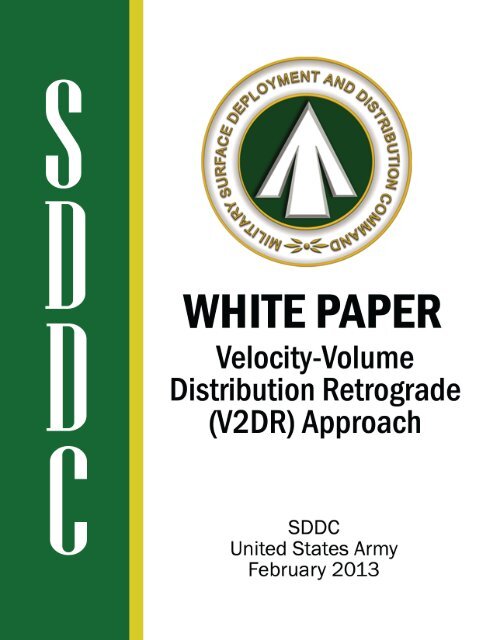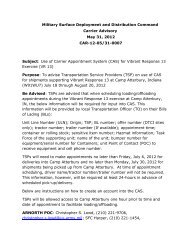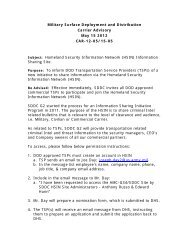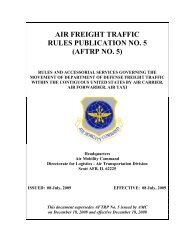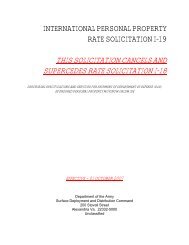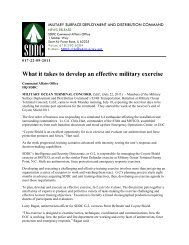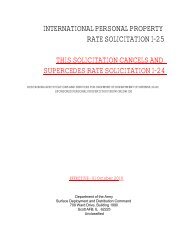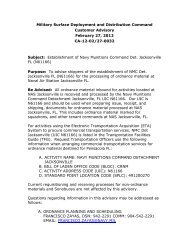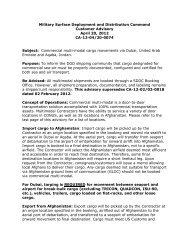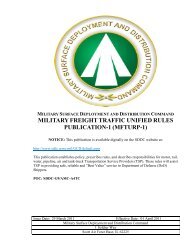Retro-WhitePaper - SDDC - U.S. Army
Retro-WhitePaper - SDDC - U.S. Army
Retro-WhitePaper - SDDC - U.S. Army
- No tags were found...
Create successful ePaper yourself
Turn your PDF publications into a flip-book with our unique Google optimized e-Paper software.
ChallengeThe R4D movement mission in AFGwill require innovation and creativityto solve the movement challengein order to meet national objectives.Given the physical, environmental,political, enemy threats, operationalconstraints, and now cost factors, U.S.forces must overcome large impedimentsto attain success. Commandersinside the Combined Joint OperationsArea - Afghanistan (CJOA-A)want velocity (move faster) andMilitary Services want volume (lowercost). Balancing speed and cost ina Defense Transportation System ischallenging when given multiple operationalconstraints such as; universalJOPES RDDs, military shippingdocumentation errors, inconsistentdisposition instructions, and CombatantsCommands (COCOMs) mandateddistribution routing that impact coston the MM contract. These factorssub-optimize the use of commerciallyavailable distribution networks, anddrive costly transportation actionsfrom CONUS ports to final destinationlocations. (Figure 1)DiscussionAfghanistan, unlike Iraq, does nothave a theater specific location thatallows surface movement and receptionof outbound cargo. In order tomeet the end of CY14 goal, velocityAfghanistan, unlike Iraq, does not have a theaterspecific location that allows surface movementand reception of outbound cargo. In order tomeet the end of CY14 goal, velocity and volumeare essential to success.and volume are essential to success.<strong>SDDC</strong> created a Velocity-VolumeDistribution <strong>Retro</strong>grade (V2DR)approach to outline our concept tosupport R4D operations. The V2DRis based on the following three corepremises: 1) necessity to move largeamount of cargo in a very short time,2) overcoming multiple impediments,i.e., POL-MIL, weather, route saturation,3) cost conscience transportationoperations. This approach synchronizesJOPES planning with contractacquisition tools to meet operationalrequirements. Focuses on culturalchanges to the traditional RLD/RDDJOPES records building model inorder to optimize commercial bestbusiness practices.V2DR leverages point-to-point movementflow to maximize efficienciesgained through volume and effectivenessthru velocity. At the same timethe acquisition MM contract reflectsthe emphasis on velocity to removecargo from AFG but does not suboptimize carriers established transportationnetwork to allow for volumemovement to CONUS.<strong>SDDC</strong>’s concept in applying enterprisedistribution model – Velocity-Volume Distribution (V2DR).n Adjust TPFDD Letter of Intent(LOI) guidance for retrograde toallow expanded movement timesoutside of CJOA-A in order to allowbetter rail/ship consolidation of rollingstock/non-rolling stock.n Long range Strategic Materielmovements forecasting plan.n Inserting transportation planningearlier in the equipment retrogradeprocess.n Create strategic shipment destinationsof key rolling stock and nonrollingstock items – shipping grid.n Meter CONUS flow times.n Ensure accurate and timely shippingdocumentation (i.e. TransportationControl and Movement Document(TCMD), HAZDECs, etc).n Fully exploit best value routingmethods utilizing the acquisition con-4Delivering Trust
tracting tool (i.e. MM) as designed.Enterprise R4D StrategicPlanning. Executing V2DR meanslong range, level four planning mustoccur to develop feasible Best ValueRouting determinations. Moving theCOCOM validation requirement 60days to the left will create a volumeof work in progress to maximize thepipeline in order to incentivize carriersto better position assets alongtheir transportation assets in order toachieve velocity. This allows <strong>SDDC</strong>to retrograde 87% of MM movementout of AFG, book 100% of theSeaport of Embarkation to Seaportof Debarkation (SPOD), and mange100% of traffic from SPOD to finaldestination.Mitigation of OperationalConstraints. The mitigation ofoperational constraints focuses on theemployment of JOPES in retrogradeplanning and execution.As a planning tool, JOPES providesa framework for movement data andrequirements that facilitates deployment/redeployment. In V2DR,however, the role of JOPES planningdates such as Ready to Load (RLD),available to load, and RDD, serve tobuild speed and volume. Key is theextension of JOPES RDDs to allowmore time on the tail end of movementso better cost options are generatedusing rail during the CONUS lift.TheWarfighter isour No. 1priorityBest Value RoutingDecisions. Best Value Routingfocuses on aligning the COCOMoperational requirements to redeploymentand retrograde contracting performanceat the best cost. <strong>SDDC</strong> employsboth USC-7 and MM contractto fulfill theater generated movementrequirements for Military ServiceDepartments and others via the PAK-GLOC, NDN, or MM routing.At present, MM represents over 87%of the movements out of AFG whichvalidates the need for MM capacity.Although capacity exists within thedistribution network to meet USFOR-A’s retrograde goals of 1,200 rollingstock and 1,000 non-rolling stockor higher, greater opportunities toreduce cost are possible with the rightTPFDD rules and JOPES application.(Figure 2)Afghanistan <strong>Retro</strong>grade toCONUS - Lines ofCommunication NetworkAssessmentDelivering Trust 5
Joint Staff Route Mix CostAnalysis Scenarios*n Scenario 1: 50% Multi Modal/100% PAKGLOC/ COST:$4.1Bn Scenario 2: 100% Multi Modal/0% PAKGLOC/ COST: $5.3Bn Scenario 3: 75% Multi Modal/75% PAKGLOC/ COST: $4.8Bn Scenario 4: 100% Multi Modal/75% PAKGLOC/ COST: $4.6Bn Scenario 5: 100% Multi Modal/100% PAKGLOC/ COST: $4.4B* Data based on percentage of routeusage goals and shrinking time line.Lines of Communication (LOC)Assessment.Northern DistributionNetwork:n NDN grew to become fully operationalfor the inbound resupply ofU.S. forces.n Pure surface NDN is two to fourtimes more expensive than usingthe PAKGLOC but still significantlycheaper than MM.n The amount of cargo that hassuccessfully transited this route wasminimal and has an unproven capacity.Pakistan Ground Linesof Communication:n The PAKGLOC was established in2002 and moved 30% of all inboundOEF cargo taking an average of 54days to move CONUS origin cargo tothe AFG-PAK border.n The pure surface movement alongthe PAKGLOC is by far the BestValue Routing for retrograde cargo.The VelocityVolume Distribution<strong>Retro</strong>grade (V2RD)approach will achievethe desired balanceof the distributionnetwork necessaryto meet movementrequirements.n Prior to the 2011 closure, the PAK-GLOC was the only surface route thatallowed consistent two-way flow ofcargo.n Until Pakistani political issues arefully resolved, this important GLOCwill be unable to be leveraged in thefull drawdown of AFG forces. As aresult of these limiting operationalcapabilities, DOD relied on MM(air and sea) transport, a more costlytransportation option.Door To Door CONUS<strong>Retro</strong>grade CostAnalysis:n With current “Port” booking scenarios,the shipper actually realizes acost increase regardless of RDD. Thebilling rate in USC includes deliveryto final destination. However, whenshipments are stopped at the port,they must be re-booked via a GlobalFreight Management (GFM) contract.This cost is passed through to theshipper, resulting in two payments forthe same port-to-door move. Costsassociated with the second move canbe reduced by extending the RDD toallow for aggregation of cargo andutilization of rail vs. truck movement.n DOD owns a fleet of 68’ and 89’flatbed rail cars used to transportheavy equipment such as Abrams,Bradley’s, DOD rolling stock and20’/40’ containers.n Commercial rail carriers operate inevery major CONUS water port. Thebig five U.S. rail carriers (BNSF, UP,Kansas City Southern, Norfolk Southern,and CSX) all run intermodal operations,cargo exchange agreements,and have business operations with the400 plus short line rail carriers in theU.S. All major DOD depots are connectedto the CONUS rail interchange(figure 1).n Rate comparison for USC-7 doorto-doortruckline haul rate versus railtendered GFM CONUS port-to-doorrail rate from Port of Charleston.n <strong>SDDC</strong> G9/TCAQ is currentlyreviewing the USC-7 contract to incorporatea rail rate option for returningCONUS retrograde equipment.Current USC rate is based on perconveyance truckline CONUS haulrate. Rates review will be based ontruckline haul rates vs. rail.n Consolidation at CONUS DODsites need to be reviewed for atemporary aggregation solution ofretrograde equipment to avoid portstorage fees, carrier storage fees,depots/installations congestion. Theuse of Military Ocean Terminal,Sunny Point, Military Ocean TerminalConcord, other large DOD facilitiessuch as Bliss, Bragg, Hood, Benning,and Stewart, all have rail access thatcould be used as intermediate cargostops. Historically rail carriers havenot charged DOD extra fees for useof their rail cars that are used to holdcargo. Also, we do not pay for storageat Charleston.n <strong>Army</strong> depots and commercialreceiving facilities will play a keyrole in the scheduling and receivingof equipment for retrograde, and musteffectively manage fleet availability.6Delivering Trust
RecommendationsThe V2DR approach will achieve thedesired balance of the distributionnetwork necessary to meet movementrequirements. Using methodsof retrograde best value routing fromMM sites, the PAKGLOC, and NDNroutes create flexibility of flow.Exploiting Best Value Routing requiressound equipping forecasts, freeflow of carrier MM sites, adjustedretrograde RDDs, and ship/rail cargoaggregation/consolidation to exploittransportation efficiencies from thecommercial carriers at the SPOD.Key activities of V2DR consist of thefollowing:n Mode Neutral – Best Value Routingusing USC-7 and MM contracts thatfit within USCENTCOM geographicalconstraints.n Synchronize an FY13-14 retrograde/resetplan with strategic shipmentpartners (<strong>Army</strong>, USMC, etc.) inorder to develop a sound transportationplan for returning retrogradeequipment.n Extend JOPES timeline for retrogradeequipment while allowingrealistic RDDs setting for equipmentand cargo.n Build requirement packages incrementally(i.e., 50 per day for onemonth, then 75 per day for the nextmonth and finally to 100 a day) tosynchronize the line haul capacity(see figure 3)n Integration of TSPs MM sites withUSCENTCOM mandated MM locations.n Strategic equipment forecastingwill allow better batching dispositioninstructions.n Identify and designate strategic retrogradeCONUS SPODs. Trans-shipretrograde equipment from CONUSport to final destination via the mostcost efficient manner and in concertwith industrial base reception capabilities.n Synchronizing JOPES and the MMcontract.n Make cargo available 60 daysbefore RLD.n Incentivize the carrier to pick upand move cargo out of AFG by RLD+21 to the ILOC.n Carrier performance measures thatinclude making RLD (i.e., first datecargo is available for pickup), gettingcargo out of AFG to the ILOC, meetingRDD, and providing the requisiteITV.n Designating CONUS strategic portsas transship locations.n Utilizing TWCF to cover port todoor costs.n Evaluate feasibility of “single ship”solution for retrograde operations.n Address/create a contract for equipmentconsolidation requiring localtransfer from carrier specific ports ofcall to designated staging areas.Delivering Trust 7
V2RD Integrated Planning Team:Colonel David Gaffney, Deputy CommanderColonel Glenn Baca, Deputy Chief of Staff, G-3Mr. William Patterson, Chief, Accounting & Systems DivisionMs. Marisa Bealor, Deputy Chief, Command Operations CenterMr. Scott Wadyko, Chief, NORTHCOM BranchMr. Bobby Lyons, Chief, CENTCOM BranchMr. Brian Rivera, Chief, Global Business Development DivisionPoint of Contact for V2DR White Paper:Ms. Marisa Bealor, Deputy Chief, Command Operations CenterCommercial: 618-220-5890DSN: 770-5890Email: usarmy.scott.sddc.mbx.hqcoc@mail.mil


